#Olives are jewish symbol
Text
Jewish identity: *existing for more than 4,000 years*
Palestinians:
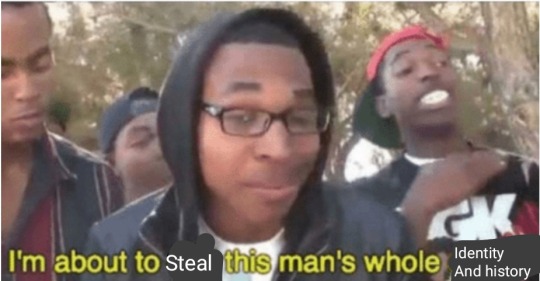
Disclaimer: i don't have problem with the palestinian people just with the fact that they stole jewish indigenous identity and brainwashed the world into thinking arabic identity is native. You won't see this happen with americans
#sorry not sorry#controversial take#jews are indigenous#Palestinian identity is made out of arabic identity#Culture#And language#Arabic is not native to canaan#Ancient hebrew is#Arabs are not native to canaan#Jews are#Islam is not native to canaan#Judaism is#Olives are jewish symbol#For peace#jumbler#israel#palestine#am israel hai#from the river to the sea yall can suck my d#jewish#free israel from terrorism#free gaza from hamas#jews#ישראבלר#Idc about yall whiny ass#Free israel from leftist bigots#History#Identity#goyim try not to erase jewish history challenges: impossible#gaza
29 notes
·
View notes
Text

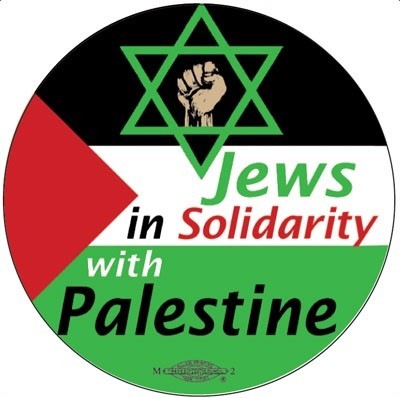
Just purchased! (Second pic is a sticker 10-pack)
#i'm doing more than just buying stuff haha (emailing reps etc) just wanted to show this off#love the olive branch on the shirt#isn't it ironic how palestine is known for their olive trees/olive oil and the olive branch is also a symbol of peace?#disclaimer/reminder though that i am only culturally jewish - doing my own thing religion-wise#but i feel like it's so important to use my heritage to speak out and show that many jews are against this#also i did have family literally in concentration camps so yeah#mine#jews for palestine#jews against israel#jews against genocide#jews for ceasefire#not in our name#not in my name
9 notes
·
View notes
Text

[source]
[image description: a poster saying "JEWS say FREE PALESTINE" "STOP THE GENOCIDE" and "NOT IN OUR NAME". the graphics are six Palestinian flags radiating around an olive branch, the red triangles from the flags forming a mogan david, a common Jewish symbol. This is all within a frame - a window or a mirror, blue sky and clouds around the flags.]
644 notes
·
View notes
Text
I'm scheduling this for after Tu Bishvat is over cuz fuck @bringmemyrocks you for ruining my tree day fun
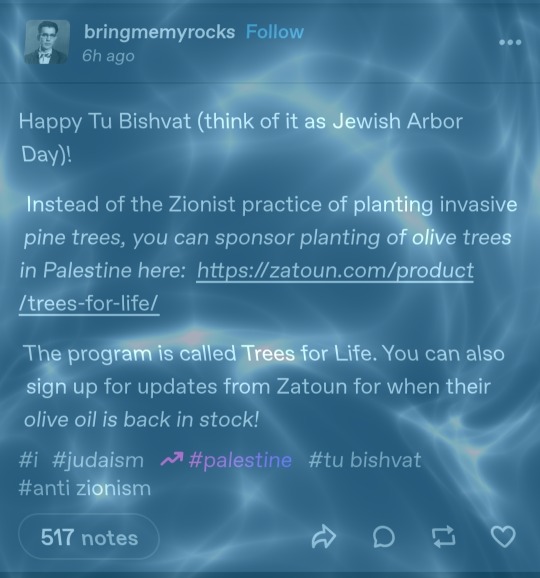
so, things to say about this:
1) good job turning Tree Day into a political discourse, taking our culture and making it about Palestinians. definitely not cultural appropriation at all.
2) Olives have been a major significance in Jewish culture. the story of Noah's arc with the dove carrying an olive branch, the Miracle of Hanukkah with the jug of olive oil that lasted for 8 days, and the countless references to them in the Torah. they're a symbol of peace, prosperity and life in Judaism.
3) there's an ongoing debate on wether the Jerusalem Pine is an invasive species or not, it is spreading over some areas of Israel and is an ongoing concern, but there's no practice of planting them deliberately. I have no idea where you got this from.
4) it's not "Jewish Arbor day", it's much more than that. it's a day of ecological awareness, agricultural celebration, and appreciation of local harvest. it's THE BIRTHDAY OF THE TREES. we celebrate the 7 species, listed in the Torah as the special products of Israel (as in, our local specialties).
אֶ֤רֶץ חִטָּה֙ וּשְׂעֹרָ֔ה וְגֶ֥פֶן וּתְאֵנָ֖ה וְרִמּ֑וֹן אֶרֶץ־זֵ֥ית שֶׁ֖מֶן וּדְבָֽשׁ
aka: land of are wheat and barley, and grape and fig, and pomegranates, olive oil, and [date] honey.
we're celebrating our local produce. We've had a local holiday for environmental awareness for thousands of years.
you could have talked about that charity without spreading disinformation, and without bringing up our fucking holiday. good day to you.
634 notes
·
View notes
Text
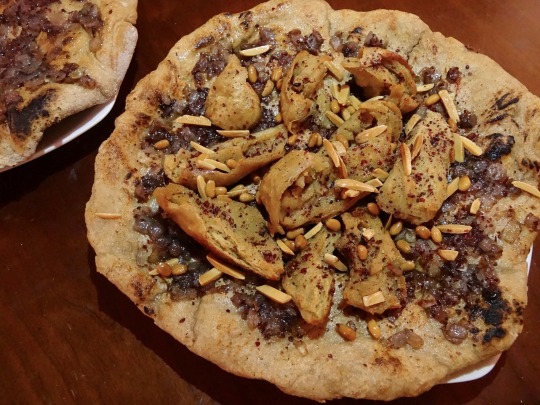

[ID: Two large flatbreads. The one in the center is topped with bright purple onions, faux chicken, fried nuts, and coarse red sumac; the one at the side is topped with onions and sumac. Second image is a close-up. End ID]
مسخن / Musakhkhan (Palestinian flatbread with onions and sumac)
Musakhkhan (مُسَخَّن; also "musakhan" or "moussakhan") is a dish historically made by Palestinian farmers during the olive harvest season of October and November: naturally leavened flatbread is cooked in clay ovens, dipped in plenty of freshly pressed olive oil, and then covered with oily, richly caramelized onions fragrant with sumac. Modern versions of the dish add spiced, boiled and baked chicken along with toasted or fried pine nuts and almonds. It is eaten with the hands, and sometimes served alongside a soup made from the stock produced by boiling the chicken. The name of the dish literally means "heated," from سَخَّنَ "sakhkhana" "to heat" + the participle prefix مُـ "mu".
I have provided instructions for including 'chicken,' but I don't think the dish suffers from its lack: the rich, slightly sour fermented wheat bread, the deep sweetness of the caramelised onions, and the true, clean, bright expressions of olive oil and sumac make this dish a must-try even in its original, plainer form.
Musakhkhan is often considered to be the national dish of Palestine. Like foods such as za'tar, hummus, tahina, and frika, it is significant for its historical and emotional associations, and for the way it links people, place, identity, and memory; it is also understood to be symbolic of a deeply rooted connection to the land, and thus of liberation struggle. The dish is liberally covered with the fruit of Palestinian lands in the form of onions, olive oil, and sumac (the dried and ground berries of a wild-growing bush).
The symbolic resonance of olive oil may be imputed to its history in the area. In historical Palestine (before the British Mandate period), agriculture and income from agricultural exports made up the bulk of the economy. Under مُشَاعْ (mushā', "common"; also transliterated "musha'a") systems of land tenure, communally owned plots of land were divided into parcels which were rotated between members of large kinship groups (rather than one parcel belonging to a private owner and their descendants into perpetuity). Olive trees were grown over much of the land, including on terraced hills, and their oil was used for culinary purposes and to make soap; excess was exported. In the early 1920s, Palestinian farmers produced 5,000 tons of olive oil a year, making an average of 342,000 PL (Palestinian pounds, equivalent to pounds sterling) from exports to Egypt alone.
During the British Mandate period (from 1917 to 1948, when Britain was given the administration of Palestine by the League of Nations after World War 1), acres of densely populated and cultivated land were expropriated from Palestinians through legal strongarming of and direct violence against, including killing of, فَلّاَحين (fallahin, peasants; singular "فَلَّاح" "fallah") by British troops. This continued a campaign of dispossession that had begun in the late 19th century.
By 1941, an estimated 119,000 peasants had been dispossessed of land (30% of all Palestinian families involved in agriculture); many of them had moved to other areas, while those who stayed were largely destitute. The agriculturally rich Nablus area (north of Jerusalem), for example, was largely empty by 1934: Haaretz reported that it was "no longer the town of gold [i.e., oranges], neither is it the town of trade [i.e., olive oil]. Nablus rather has become the town of empty houses, of darkness and of misery". Farmers led rebellions against this expropriation in 1929, 1933, and 1936-9, which were brutually repressed by the British military.
Despite the number of farmers who had been displaced from their land by European Jewish private owners and cooperatives (which owned 24.5% of all cultivated land in Palestine by 1941), the amount of olives produced by Palestinians increased from 34,000 tons in 1931 to 78,300 in 1945, evidencing an investment in and expansion of agriculture by indigenous inhabitants. Thus it does not seem likely that vast swathes of land were "waste land," or that the musha' system did not allow for "development"!
Imprecations against the musha' system were nevertheless used as justification to force Palestinians from their land. After various Zionist organizations and militant groups succeeded in pushing Britain out of Palestine in 1948—clearing the way for hundreds of thousands of Palestinians to be dispossessed or killed during the Nakba—the Israeli parliament began constructing a framework to render their expropriation of land legal; the Cultivation of Waste Lands Law of 1949, for example, allowed the requisition of uncultivated land, while the Absentees’ Property Law of 1950 allowed the state to requisition the land of people it had forced from their homes.
Israel profited from its dispossession of millions of dunums of land; 40,000 dunums of vineyards, 100,000 dunums of citrus groves, and 95% of the olive groves in the new state were stolen from Palestinians during this period, and the agricultural subsidies bolstered by these properties were used to lure new settlers in with promises of large incomes.
It also profited from the resulting "de-development" of the Palestinian economy, of which the decline in trade of olive oil furnishes a striking example. Palestinian olive farmers were unable to compete with the cheaper oils (olive and other types) with which Zionist, capital-driven industry flooded the market; by 1936, the 342,000 PL in olive oil exports of the early 1920s had fallen to 52,091 PL, and thereafter to nothing. While selling to a Palestinian captive market, Israel was also exporting the fruits of confiscated Palestinian land to Europe and elsewhere; in 1949, olives produced on stolen land were Israel's third-largest export. As of 2014, 12.9% of the olives exported to Europe were grown in the occupied West Bank alone.
This process of de-development and profiteering accelerated after Israel's military seizure of the West Bank and Gaza in 1967. In 1970, agriculture made up 34% of the GDP of the West Bank, and 31% of that of Gaza; in 2000, it was 16% and 18%, respectively. Many of those out of work due to expropriated or newly unworkable land were hired as day laborers on Israeli farms.
Meanwhile, Palestinians (and Israeli Palestinians) continued to plant and cultivate olives. The fact that Palestinians do not control their own water supplies or borders and may expect at any time to be barred by the military from harvesting their fields has discouraged investment and led to risk aversion (especially since the outmoding of the musha' system, which had minimized individual risk). In this environment, olive trees are attractive because they are low-input. They can subsist on rainwater (Israel monopolizes and poisons much of the region's water, and heavily taxes imports of materials that could be used to build irrigation systems), and don't require high-quality soil or daily weeding. Olive trees, unlike factories and agricultural technology, don't need large inputs of capital that stand to be wasted if the Israeli military destroys them.
Olive trees are therefore the chosen crop when proving a continued use of land in order to prevent the Israeli military from expropriating it under various "waste" or "absentee" land laws. Palestinians immediately plant olive seedlings on land they have been temporarily forced from, since even land that has lain fallow due to status as a military closed zone can be appropriated with this justification. The danger is so pressing that Palestinian agronomists encouraged this habit (as of 1993), despite the fact that Israeli competition and continual planting had lowered olive crop prices, and despite the decline in soil quality that results from never allowing land to lie fallow. In more recent years, olive trees have yielded primary or supplementary income for about 100,000 Palestinian families, producing up to 191 million USD in value in good years (including an average of 17,000 tons of olive oil yearly between 2001 and 2009).
Israeli soldiers and settlers have famously uprooted, vandalized, razed, and burned millions of these olive trees, as well as using military outposts to deny Palestinian farmers access to their olive crops. It prefers to restrict Palestinians to annual crops, such as vegetables and grains, and eliminate competition in permanent crops, such as fruit trees.
This targeting of olive trees increases during times of intensified conflict. During the currently ongoing olive harvest season (November 2023), Gazan olive farmers have reported being targeted by Israeli war planes; some farmers in the West Bank have given up on harvesting their trees altogether, due to threats issued by organized networks of settlers that they would kill anyone seen making the attempt.
The rootedness of olive trees in the history of Palestine gives them weight as a symbol of homeland, culture, and the fight for liberation. Palestinian olive harvest festivals, typically celebrated in October with singing, dancing, and eating, have inspired similar events elsewhere in the world, aimed at sharing Palestinian food and culture and expressing solidarity with those living under occupation.
Support Palestinian resistance by calling Elbit System’s (Israel’s primary weapons manufacturer) landlord, donating to Palestine Action’s bail fund, and donating to the Bay Area Anti-Repression Committee bail fund.
Ingredients:
For the dish:
2 pieces taboon bread, preferably freshly baked
2 large or 3 medium yellow onions (480g)
1 cup first cold press extra virgin olive oil (زيت زيتون البكر الممتاز)
1 Tbsp coarsely ground Levantine sumac (سماق شامي / sumaq shami), plus more to top
Ground black pepper
For the chicken (optional):
500g chicken substitute
5 green cardamom pods, or 1/4 tsp ground cardamom
4 cloves, or pinch ground cloves
1 Mediterranean bay leaf
1 Tbsp ground sumac
For the nut topping (optional):
2 Tbsp slivered almonds
2 Tbsp pine nuts
Neutral oil, for frying

Notes on ingredients:
Use the best olive oil that you can. You will want oil that has some opacity to it or some deposits in it. I used Aleppo brand olive oil (7 USD a liter at my local halal grocery).

If you want to replace the taboon bread with something less laborious, I would recommend something that mimics the rich, fermented flavor of the traditional, whole-wheat, naturally leavened bread. Many people today make taboon bread with white flour and commercial yeast—which you might mimic by using storebought naan or lavash, for example—but I think the slight sourness of the flatbread is a beautiful counterpoint to the brightness of the sumac and the sweetness of the caramelized onions. I would go with a sourdough pizza crust or something similar.
Your sumac should be coarsely ground, not finely powdered; and a deep, rich red, not pinkish in color (like the pile on the right, not the one on the left).

For this dish, a whole chicken is usually first boiled (perhaps with spices including bay leaves, cardamom, and cloves) and then baked, sometimes along with some of the oil from frying the onions. I call for just frying or baking instead; in my opinion, boiling often has a negative effect on the texture of meat substitutes.
Instructions:
For the onions:
1. Heat a cup of olive oil in a large skillet or pot. Fry onions on medium-low, stirring often, for 10 minutes or until translucent.

2. Add 1 Tbsp sumac and a few cracks of black pepper and reduce to low. Cook for another 30 minutes, stirring occasionally, until onions are sweet, reduced in volume, and pinkish in color.

For the chicken:
1. Briefly toast and finely grind spices except for sumac (cardamom, cloves, and bay leaf). Filter with a fine mesh sieve. Dip 'chicken' into the pot in which you fried the onions to coat it with olive oil, then rub spices (including sumac) onto the surface.

2. Sear chicken in a dry skillet until browned on all sides; or bake, uncovered, in the top third of an oven heated to 400 °F (200 °C) until browned.
For the nut topping:
1. Heat a neutral oil on medium in a small pot or skillet. Add almonds and fry for 2 minutes, until just starting to take on color. Add pine nuts and fry until both almonds and pine nuts are golden brown. Remove with a slotted spoon.
To assemble:
1. Dip each flatbread in the olive oil used to fry the onions, then spread onions over the surface.
Some cooks dip the bread entirely into oil; others press it lightly into the surface of the oil in the pot on both sides, or one side; a more modern method calls for mixing the olive oil with chicken broth to lighten it. Consult your taste. I think the bread from my taboon recipe stands up well to being pressed into the oil on both sides without tearing or becoming soggy.
2. Top flatbread with chicken and several large pinches more sumac. Bake briefly in the oven (still heated to 400 °F / 200 °C), or broil on low, for 3-5 minutes, until the sumac and the surface of the bread have darkened a shade.
3. Top with fried nuts.
Musakhkhan is usually eaten by ripping the chicken into bite-sized pieces, tearing off a bit of bread, and eating the chicken using the bread.
Some cooks make a layered musakhkhan, adding two to three pieces of bread covered with onions on top of each other before topping the entire construction with chicken and pine nuts.
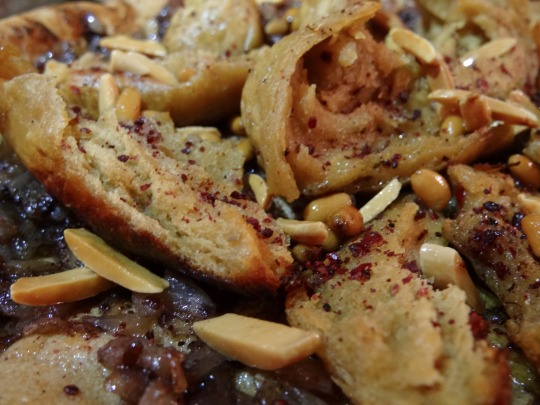
670 notes
·
View notes
Text

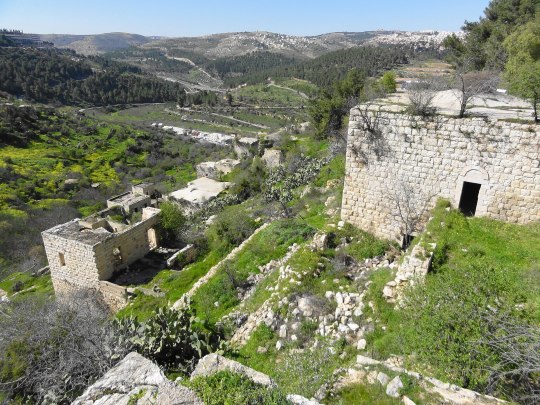
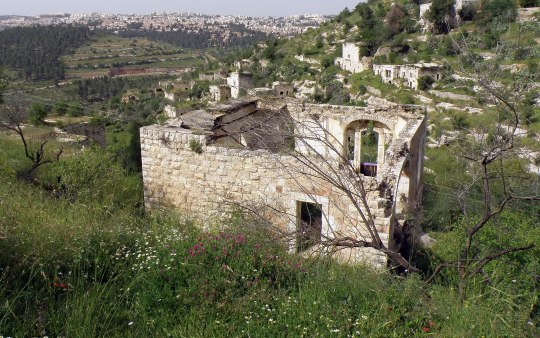

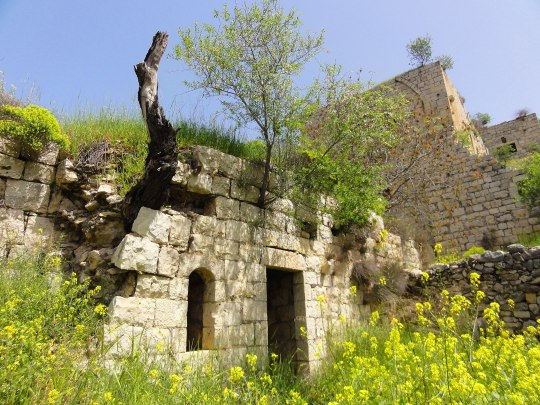
when the homes in the depopulated palestinian village of lifta were originally built is impossible to tell and most likely varies from house to house. the area's been known since ancient times, including having been written about in the hebrew bible. it's retained multiple different names throughout history - lifta by romans, nephto by byzantines, clepsta by crusaders, then lifta again by arabs. in more recent times, the area saw battle in the early 19th century, when it saw a peasant's revolt against egyptian conscription and taxation policies. (egyptian-ottoman ruler muhammad ali had attempted to become independent from the ottoman empire, and sought to use the area of "greater syria" which palestine was apart of as a buffer state.)
the village was predominantly muslim with a mosque, a maqām for local sage shaykh badr, a few shops, a social club, two coffee houses, and an elementary school which opened in 1945. its economy was based in farming - being a village of jerusalem, farmers would sell their produce in the city's markets. an olive press which remains in the village gives evidence to one of the most important crops its residents farmed. the historically wealthy village was known for its intricate embroidery and sewing, particularly of thob ghabani bridal dresses, which attracted buyers from across the levant.
lifta also represents one of the few palestinian villages in which the structures weren't totally or mostly decimated during the 1948 nakba. 60 of the 450 original houses remain intact. from zochrot's entry on lifta:

israel's absentee property law of 1950 permits the state to expropriate land and assets left behind, and denies palestinians the right to return to old homes or to reclaim their property. it's estimated that there's around 400,000 descendants of the village's original refugee population dispersed in east jerusalem, the west bank, jordan, and the palestinian diaspora.
like many depopulated palestinian houses, some of those in lifta were initially used to settle predominantly mizrahi immigrants and refugees, in this case 300 jewish families from yemen and kurdistan. the houses weren't registered in their names, and the area generally saw poor infrastructure and no resources including water and electricity provided by the government. most left in the early 1970s as a part of a compensation program to move out people who'd been settled in depopulated palestinian houses - if they didn't, they were referred to as "squatters" and evicted. (holes were even drilled in the roofs of evacuated buildings to make them less habitable). the 13 families which remain there today only managed to do so because they lived close to the edge of the village.
in 1987, the israeli nature reserves authority planned to restore the "long-abandoned village" and turn it into a natural history center which would "stress the jewish roots of the site", but nothing came of it. several more government proposals on what to do with the land had been brought up since then. this culminated in in 2021 when the israel land administration announced without informing the jerusalem municipal authorities that it issued a tender for the construction of a luxury neighborhood on the village's ruins, consisting of 259 villas, a hotel, and a mall. since 2023, they've agreed to shelve and "rethink" these plans after widespread objection.
the reasons for the objections varied significantly between the opposing israeli politicians - who see the village as an exemplar of cultural heritage and "frozen in time" model of palestinian villages before 1948 - and palestinians - who largely see the village as a witness of the nakba and a symbol of hope for their return. lifta is currently listed by unesco as a potential world heritage site, a designation netanyahu has threatened to remove several times.
many palestinians who are descendent from its former residents still live nearby. like with many other depopulated palestinian villages, they've never ceased to visit, organize tours of the village, and advocate for its preservation.
#palestine#info#nakba#my posts#the dresses link isnt specific to lifta thobs but provides a good overview#i couldn't find anything online abt lifta's embroidery but some of the book pdfs on palestinian costume i reblogged a while ago have info
381 notes
·
View notes
Text
Blog Housekeeping:
Gonna take the rest of the week off from high-effort posting and analysis. Just to recharge.
This is a marathon, not a sprint. And I need to take my own advice so I can finish this instead of burning out.
A lot of things have been upsetting to me this past week. A lot of hypocrisy from so-called activists. A lot of Jewish spaces being so flooded with antisemitism that I can’t even find Jews in them. I just need a rest.
I looked up “olive tree” on this site just for reference pix of so I could draw an olive tree. And instead I was flooded with propaganda about how Jews can’t be indigenous to Israel because of we cared so much about our land we wouldn’t destroy so many olive trees. And how important olive trees are to Palestinians. And yes. I absolutely 100% believe that Palestinians value olive trees. I believe Palestinians when they say that they value all the things they say they value.
What upsets me is that I can’t even search a symbol that is also very connected to Judaism and peace and my indigeneity without my culture being vilified and my indigeneity denied and encountering a disrespectful level of ignorance about the core values of Judaism.
Like… imagine telling JEWS we are evil for not caring enough about trees. 33% of our religion is about trees!!!!! Specific trees too! Including olive trees! I deserve to look up pictures of olive trees and be able to find a nice picture of an olive tree.
I’m not saying that nobody should post about the destruction of olive trees in Palestine. But why can’t I find any posts with olive trees that are just about the trees? Why is this symbol of peace across multiple religions and cultures being used AGAINST Jews worldwide just because of the actions of a country halfway around the world? And why do I feel like saying the truth that “Jews love trees, but not more than human life” will be a stance that gets me called evil and accused of devaluing Palestinian life. I don’t. And never have. But my goodness. I just wanted to look at a tree. Idk. It just made me sad. It was just the latest instance of a long line of stuff that has made me weary lately. Fandoms, nature pictures, everything I enjoy is just soaked in politicization rn and there is no escape. And I just…it’s overwhelming. I’ll be back and I’ll be analytical and kind and the same as I’ve always been. But I need a week to recharge myself.
73 notes
·
View notes
Note
aaaah actually wait no i take it back i do have a good one!!! doves as Hanukkah symbols all the sudden in the last couple of years. what is up with that
Rating: Capitalism
Doves themselves are a frequent motif in Jewish art throughout the world, symbolizing peace and renewal, as a reference to Noah's dove that signaled the end of the flood and rejuvenation of the world. On the other hand, doves are not generally associated with Hanukkah, which is a holiday of anti-assimilation, military victory, and Jewish nationalism. We were able to find references and track down a midrash that traces the origin of the tiny vial of olive oil that lasted for eight miraculous nights to oil made by Noah from the olives attached to the olive branch that the dove brought him at the end of the flood (see אמרי נועם by Rebbe Meir Horowitz of Dzhikov, thank you to mod @magnetothemagnificent for tracking this down).
However, it seems far more likely to us that the increasing popularity of dove decorations for Hanukkah is a result of capitalism using the dove as a so-called "non-denominational" generic peace and love symbol, due to Hanukkah's proximity to Christmas and capitalism's tendency to tepidly repackage any Christmas symbols in literally or metaphorically blue-and-silver wrapping paper to appeal to a Jewish market than that big retailers have studied the Imri Noam and were thus inspired. It's a better effort than, say, "Hanukkah ball' Christmas tree ornaments that treat Hanukkah as a trendy accessory to Christmas, and while some may find it a bit twee, if you love doves, go ahead and get that Hanukkah dove art-- it'll give you an excuse to share a cool new midrash, and we could all do with some peace after a flood.
-Mod Leora
230 notes
·
View notes
Text
As the waves of Jewish immigration intensified and the desire (overt or covert) to become a replacement to the Arab-Palestinian people increased, the Zionist leadership advocated a policy of separation on all social, political and economic fronts. One of the most visible manifestations of this separation was the Zionist campaign for the purchasing of Jewish only goods, known in Hebrew as Totzeret Ha’aretz—literally “the produce of the land.” This resulted in a clear differentiation between the permeation of Arab-Palestinian culture into Jewish life and the barriers placed on social, economic and political integration and interaction. In the words of Zerubavel, “politically, the Zionists ignored the Arabs, but culturally, they romanticized and tried to imitate them.”
For example, Dafna Hirsch, in her biographic study of hummus, describes how it was initially considered part of the local Arab-Palestinian food culture and repertoire in the 1930s, worthy of adoption due to its nutritious value. However, in the 1950s, through the process of industrialisation, mass production and marketing, it was appropriated and nationalised, and its Arab origins were supressed. The Arab-Palestinian origins of the product were omitted and marginalized and its connection to Jewish and Jewish-Israeli traditions, especially to the Mizrahi-Jewish Diaspora, emphasized. For Jewish-Israelis, hummus became a national dish, the eating of which was part-and-parcel of daily life, either purchased from Jewish-Israeli food companies, such as Telma, or consumed at home or at Mizrahi-Jewish restaurants.
The hummus example in this regard is not unique; I will demonstrate these processes by deconstructing one of Israel’s most well known dishes, the Israeli salad. There might not be a more popular dish in Israel than the Israeli salad, sometimes also referred to as Salad Katsuts (chopped salad). The salad is based on chopped vegetables (normally tomatoes, cucumbers and onions) and fresh herbs (mostly parsley but sometimes also mint) and dressed with olive oil and lemon juice. A recent book, Fresh Flavours from Israel, by Jewish-Israelii food writer Janna Gur, states that “Israelis must have their salad at least once a day.” It is an accompaniment to every meal, whether eaten at home or outside. In fact, you would be hard pressed to have a meal anywhere in Israel without it. No Israeli cookbook from the 1960s onwards is truly complete without providing a recipe for it. This is true with regards to those written for Jewish-Israeli and foreign audiences. To the unsuspecting viewer, the Israeli salad is the epitome of Israeli food culture: it is fresh, simple, healthy and [symbolizes] the strong relationship the nation has with its agricultural produce. The salad, therefore, serves as both an internal and an external banal symbol of Jewish-Israeli identity.
What are the origins of the Israeli salad? Reading through literary accounts of growing up in Israel, the salad became a staple food product in the Kibbutzim canteens, from there it moved to the Israeli army’s mess halls and to Israeli homes. The fact that the salad is mentioned mostly as a chopped vegetable salad by Israeli authors describing living in Israel in the 1930s and 1940s demonstrates that it did not arrive with the wave of Jewish immigrants from North Africa and the Arab world after the state was established in 1948. It was also not prevalent in the diet of Central and Eastern European Jewish communities, from where most immigrants came. On the other hand, there are a number of accounts, mostly by travel writers, such as Masterman and Grant in the early-1900s and that of the Mary Eliza Rogers as far back as 1865, that describe the preparation and consumption of a chopped vegetable salad in Palestine. Rogers describes the salad as accompanying most meals served by the upper and governing classes in Palestine, at the time part of the Ottoman Empire. In other words, it is either that early Zionist immigrants to Palestine independently invented the salad, or, as I argue hereafter, they imitated, adopted and later appropriated and nationalised an existing local custom.
– Ronald Ranta, “Re-Arabizing Israeli Food Culture.” Food, Culture & Society 18(4):611-627 (December 2015). DOI: 10.1080/15528014.2015.1088192
117 notes
·
View notes
Text
THE IDF TICKS EVERY STEP/STAGE OF THE GENOCIDAL PROCESS:
resources & charities for palestine & sudan
01. classification: groups in power categorizing people according to race, ethnicity, etc.
killing those palestinians and mainly targeting women and children. very sick children at that.
02. symbolization: where people who identify with religion are made to stand out because of it and ultimately stripped of it.
israeli forces are known to be against the religion of islam. slamming it as a con and made to be seen as negative.
the burning of the olive trees; a very well-known symbol for the palestinian nation. while they are an agricultural crop, it is also written in the sacred text of islam as “the blessed tree”.
03. discrimination: the dominant group denies civil rights or even citizenship to identified groups.
the rights of palestinians are being stripped away as the days go by. they live in fear on their own land because they have no rights. all because they are palestinian.
04. dehuminzation: those perceived as ‘different’ are treated with no form of human rights or personal dignity.
palestinians are being called tutsis, defined as “cockroaches”. that comment was made by the chief of the idf. they often describe them as “vermin” or “a cancer” as well. that shows to tell you how human they think palestinians are.
05. organization: genocides are always planned.
while some plans are not revealed, a lot are still shown on the media. israeli forces giving some palestinians the exception to flee, only for it to be a pre-planned attack.
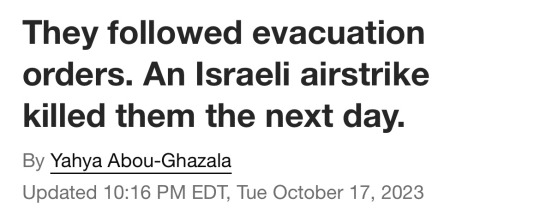
06. polarization: propaganda begins to be spread by hate groups.
israeli government taking it to social media, attempting to put palestine on blast for allegedly murdering their children, only for that photo to be fabricated and taken down.
as they try to paint palestine in a bad light, they’re only taking themselves down even lower.
07. preparation: perpetrators plan the genocide.
plan dalet executed in the civil war phase, causing the start of the long genocide against palestine. this plan was the very beginning, made out of pure zionism to establish palestine as a jewish state.
08. persecution: victims are identified because of their ethnicity or religion and death lists are drawn up.
palestinian lives taken just in 2022.


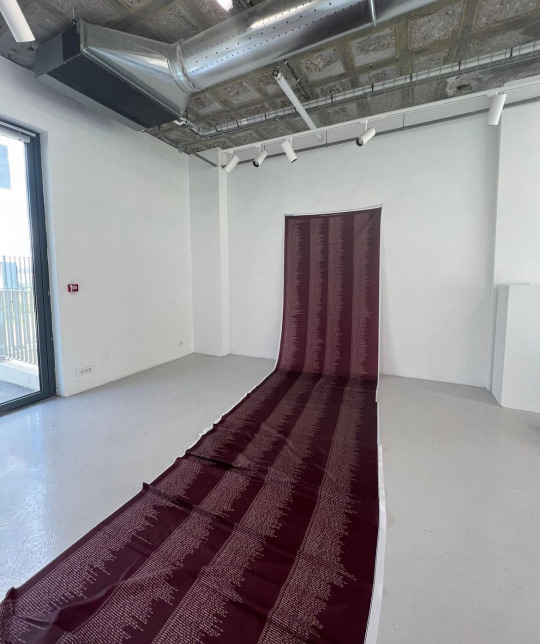
09. extermination: the hate group murders their identified victims in a deliberate and systematic campaign of violence.
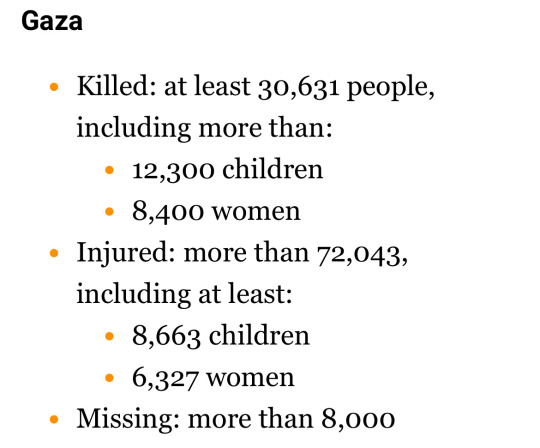
10. denial: the perpetrators or later generations deny the existence of any crime.
as disgusting as it is, even in later generations, this genocide is still present.
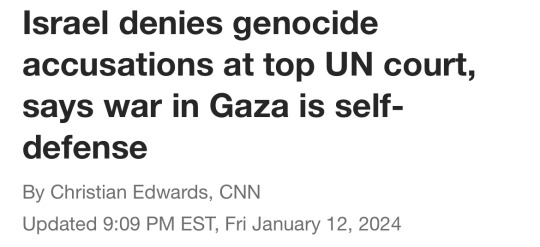
#free palestine#from the river to the sea palestine will be free#palestine#free palestine 🇵🇸#palestine awareness#important
77 notes
·
View notes
Text
Culture based on ancient Israelites, but they worship the sun and have tattoos
@mangomura asked:
Hello there!I’m writing a fantasy ethnoreligious group based off of the Ancient Israelites and Illyrian sun worshipers. In my story, these people are a nomadic group that worship a sun god known as “Shemesh.” (the Hebrew word for sun) They generally have light olive skin and wavy dark brown hair. As part of their culture, women and men tattoo their hands and foreheads with sun symbols. (This is based off the traditional tattoos among Catholic Croatian women that originated from old Illyrian and Celtic tribes.)
From what I’ve researched, tattoos are sometimes considered taboo in Judaism. I know it’s a fantasy culture, but I still want to be respectful to Judaism since I’m drawing some inspiration from the Israelites. With that being said, would tattoos be offensive in this setting? Is drawing from two cultures with different views on tattoos problematic?
For reference, I’m a Japanese, Mexican, and Black Catholic. So I’m not personally familiar with Judaism. Online research and articles have been my only resource.
I appreciate this blog so much and would value any opinions you could give. Thank you!
I’m not sanguine about having something coded as ancient Israelite that worships observable natural phenomena. A great deal of our cultural narratives about our early development specifically places us in contrast to cultures that worship something other than a formless, omnipresent God, and often specifically sun worship. Many Jewish people, both who do and who do not believe that Torah is divinely inspired or historical truth, believe that the intent of many of the laws, especially ones like the law against tattooing one’s body, may have been intentionally designed to set us apart from neighboring cultures, to create a cultural identity that was not compatible with assimilation with cultures that ate pork, had religious tattoos, or worshiped the sun.
Many people credit that distinctness of identity, that separateness, with the survival of our culture through the centuries, so to see something coded Jewish, that is, implied to be us in some meaningful way, mixed together with those opposing attributes, would not feel like positive representation.
You don’t say a lot in your ask about what aspects of Jewish or ancient Israelite culture you’re using to code this group, other than a generally Mediterranean phenotype and your use of the Hebrew word for sun as the name of their god--if that’s about the extent of it, then you don’t have a lot of revision to do to keep the bones of your idea without directly associating recognizable Jewish coding with sun worship. What if you name the sun-god something else, and include inspiration from other Bronze Age cultures along with the foundation you drew from Jewish, Croatian, and Celtic sources, to create something that skips the discomfort of muddling Jewishness together with other systems?
Basically, I don’t think it’s necessary to tear your idea down and start from scratch, just make it not overtly Jewish and you’ll have avoided a discomfort I’m sure you didn’t even know to look out for. Good luck!
Meir
395 notes
·
View notes
Note
I don't know if someone has asked this already but I saw your post about erasing the Jewish origins of kirk and spock and I realised that I don't know a whole lot. So instead of cute Christmas jumpers and such are there any lovely Jewish traditions that I could draw for them around hannuhkah or other festivals?
:)
omg this is a lovely question thank you! if anybody has any questions about jewish traditions and what i think would be really cool to see in star trek, please feel free to send me an ask or a dm or whatever. i'm also happy to read/look over any jewish star trek creations that y'all make!!! ♥️♥️♥️
jews who come across this, PLEASE add your own favorite traditions and holidays!!!
for chanukah, other than the classic menorah/chanukiyah lighting (which can be done with oil, not just candles!) one of the biggest traditions is eating fried foods, specifically latkes (potato pancakes) and sufganiyot (jelly filled donuts, also pronounced sufganiyos). sephardic jews may eat buñuelos (sorta like sopaipillas), indian jews may eat gulab jamun (milk-dough balls in syrup), etc etc there are a lot of minhagim (traditions, customs) out there
for other holidays, i'd say the major ones are rosh hashanah, yom kippur, and pesach. this got pretty long so i put explanations of those under the cut haha
rosh hashanah (lit. head of the year) is the jewish new year. it's two days long (the first and second of tishrei on the hebrew calendar, where the calendar day starts at sunset), and traditions include a lot of being in the synagogue, blowing the shofar (a ram's horn), and generally lots of being together. traditions include eating round challah (braided egg bread) and apples to symbolize the circular nature of the year, and honey bc the new year is sweet! people will often have big meals both nights with lots of being together, and on the second night it's tradition to eat a bunch of fruit you've never had before so you can say the shehecheyanu bracha, a blessing that's said when doing something you've never done before, or haven't done in at least a year. my minhag includes eating the shvat/shvas haminim (the seven species—wheat, barley, grapes, figs, pomegranates, olives, and dates); eating these dates all the way back to before the jewish exile from eretz yisrael (the land of (the people of) israel, this has nothing to do with the state of israel). we'll all try to make puns about the new year relating to each before we eat them as a sort of blessing (also it's just a lot of fun). a classic one is "i hope we have a grape new year," that sort of thing
yom kippur is the most important holiday/holy day of the jewish calendar, it's literally translated as the day of atonement. it's on the tenth of tishrei, so eight days after rosh hashanah. it's kinda difficult to describe bc even tho it is a very somber and intense day (you would never say "happy yom kippur") it is also filled with a lot of joy, and by the end of it a lot of people kinda want to do it all over again. it's characterized by spending basically all day in shul (the yiddish word for synagogue), partially because it's a fast day (so no food or water for 25 hours) so there isn't much else you can do. for people who can't fast like myself, you can do other fasts, like a technology fast or a talking fast, or some might not do anything! one tradition here is tashlich, which is done in a few different ways. first, you turn your pockets inside out and brush your clothes off over a body of water. sometimes people will also feed bread crumbs to fish. these are to sorta symbolize our "sins" (a word that means something completely different in judaism vs in christianity) being washed away. the break fast meal is a time for a lot of really good food and good conversation, and everybody's always in a really good mood and it's really lovely!
pesach (passover) is another very important holiday on the jewish calendar. it takes place in the spring, and it marks the exodus of the israelites from egypt. where both the previous holidays mentioned have work prohibitions the whole time (melacha, the word for work in this case, has a very specific definition), pesach only has these prohibitions on the first two and last two days of pesach, which is in total either seven or eight days. people in eretz yisrael, reform, and reconstructionist jews generally observe it as seven days; while conservative/mizrahi (this title has nothing to do with political leanings) and orthodox jews generally observe it as eight days. it is traditional to have a seder each of the first two nights, which is sorta like a mix between a meal and a play and a ritual. there's a very specific order in which you do things, and people will use a haggadah to recount the story of the exodus during the meal. one of the biggest parts of pesach is to not eat anything leavened for the entire duration. this ofc means different things in different communities, but so as to not make this already long post way longer, i'll just say this is when jews eat matzah/matzo, which are sorta like crackers. this is the time period when kashrut (jewish laws of food) is most stringent, and there's So Much that you can't eat during this time
other runners up before i get to my favorite tho. in no particular order there's purim (sorta like halloween, we read megillat/megillas esther (the book of esther), and it's a mitzvah (commandment) to get drunk. a lot of people cross dress), sukkot/sukkos (you build a sukkah (little booth) and wave some plants around and try to spend as much time outside as possible), shavuot/shavuos (celebration of receiving the torah, eat lots of dairy and study torah), simchat/simchas torah (celebration of finishing reading rhe torah and starting all over again, lots of dancing, the torah's paraded around and sometimes the whole scroll is unrolled), tu beshvat (the new year of the trees, you eat a lot of fruit), and many more!
my favorite jewish holiday is shabbat/shabbos, which is every week from sundown friday to sundown saturday. there's a work prohibition, and it's generally a day of rest and torah study and being in community. kabbalat shabbat is the ritual/celebration that kicks shabbat off. people usually light candles, drink wine, and eat challah friday night. there's also a tradition of eating stuff with garlic in it friday night, bc the talmud says it's an aphrodisiac, and it's a mitzvah to have sex with your partner on shabbat (and good luck if your child was conceived on shabbat). saturday morning people often go to services, where lots of prayers are said and the torah portion of the week is chanted. then everybody goes home and often takes a nap. i like to study torah at this time. to close shabbat out, there's havdalah, when a special candle is lit, we smell sweet spices to wake the mind up to get ready to go back to the real world, check our nails under the candlelight, drink wine, and sing some more songs. havdalah's bittersweet, i know i personally am always sad to exit shabbat and having to leave that (to quote a very important rabbi) palace in time
to close this out, i'm gonna add some links and give recommendations for further readings. also feel free to send me asks or dms if you have any other questions, or reach out if you'd like someone to read/look over a creation of yours to make sure you're portraying jewish traditions well!!!
i started a collection of star trek fics that deal with jewish food traditions specifically, so if you have something like that posted to ao3 feel free to add it! https://archiveofourown.org/collections/trek_through_jewish_food
a very good resource for learning more about jewish traditions is the website my jewish learning! chabad also has a good website with lots of resources, but chabad is a hasidic organization so it's important to keep in mind that most jews don't follow the traditions they list exactly. really keep that in mind with anything you read. there's a saying "two jews, three opinions," bc jews famously never agree on anything and there'a a massive diversity of jewish practices and traditions. some good links for further readings:
list of jewish holidays [x]
the meaning of melacha in terms of shabbat [x]
it's important to note that even if on paper there are prohibitions against something, many people will still do the thing. it's up to that person, their minhag, and their rabbi
what is a mitzvah [x]
kashrut [x]
important ritual objects [x]
#sorry this got so long you activated my infodump card#jumblr#star trek#jewish star trek#חנוכה#ראש השנה#יום כיפור#ימים נוראים#פסח#שבת#jewish holidays#jewish culture#garneneva#jewish kirk#jewish spock
24 notes
·
View notes
Text


Left: detail of an icon of Jesus's Palm Sunday Procession.
Right: detail of a 1791 replication of a bas relief of the Triumph of Titus
[T]his demonstration harbored a dangerous message that would lead to Jesus's public execution by the end of the week. The way Jesus entered Jerusalem at the beginning of Passover week was a strategically organized demonstration.
Jesus's entire ministry was headed toward Jerusalem. Every time he had to leave a large crowd of sick people begging to be healed, it was because his journey was aimed toward Jerusalem. Word of Jesus's message had already spread to Jews in Jerusalem, and they were prepared to participate in these planned demonstrations. Mark 11 tells us that when Jesus and his disciples were approaching Jerusalem, he told two of his disciples, "Go into the village ahead of you, and immediately as you enter it, you will find tied there a colt that has never been ridden; untie it and bring it. If anyone says to you, 'Why are you doing this?' just say this, 'The Lord needs it and will send it back here immediately.'"
We don't know who was assigned to tie up the colt at the entrance, but taking the colt communicated to the crowds waiting in Jerusalem that Jesus was about to arrive. From the Mount of Olives, Jesus entered through the east entrance of Jerusalem on the colt while a crowd surrounded him, preparing the road for Jesus by spreading their cloaks and "leafy branches that they had cut in the fields" on the ground. And they shouted, "Hosanna! Blessed is the one who comes in the name of the Lord! Blessed is the coming kingdom of our ancestor David! Hosanna in the highest heaven!"
This deliberate sequence of actions was a symbolic reenactment of the prophecy of Zechariah. Zechariah 9:9 says, "Rejoice greatly, O daughter Zion! Shout aloud, O daughter Jerusalem! Lo, your king comes to you; triumphant and victorious is he, humble and riding on a donkey, a colt, the foal of a donkey." Matthew even directly quotes the verse in his account.
This was a purposefully timed demonstration that would also remind people of the next verse in Zechariah 9: "He will cut off the chariot from Ephraim and the war-horse from Jerusalem; and the battle bow shall be cut off, and he shall command peace to the nations; his dominion shall be from sea to sea, and from the River to the ends of the earth."
Although the gospel accounts do not report this detail, we know that the Roman governor Pontius Pilate arrived in Jerusalem at the beginning of the Passover Week as well. First-century Jewish historian Josephus wrote that during every Passover, Pontius Pilate and a legion of Roman soldiers spent the week in Jerusalem because of an increased chance of an uprising as Jews celebrated the event of the Exodus. The Romans wanted to make sure nobody got any dangerous ideas as they recounted God's attack on Egypt and the liberation of the Israelites.
So as Jesus humbly entered Jerusalem from the east on a donkey, surrounded by a crowd of peasants and leafy branches, Pontius Pilate was likely entering Jerusalem from the west on a chariot led by a war horse, surrounded by a legion of Roman soldiers with armor and deadly weaponry. In their book on Jesus's last week in Jerusalem, John Dominic Crossan and Marcus Borg point out, "What we often call Jesus's triumphal entry was actually an anti-imperial, anti-triumphal one, a deliberate lampoon of the conquering emperor entering a city on horseback through gates open in abject submission.
The symbolism is packed with meaning for the lives of those in the crowd surrounding Jesus. This demonstration exposed two warring kingdoms: the kingdom of Rome, with the power and weapons on their side, and the kingdom of God with the people on their side, desperate for liberation.
Damon Garcia (The God Who Riots: Taking Back the Radical Jesus, pages 146-148). Bolded emphases added.
#Christianity#Jesus Christ#Kingdom of God#The World#Palm Sunday#peace#war#imperialism#Pontius Pilate#symbolism#Gospel of Mark#Book of Zechariah
7 notes
·
View notes
Text
Palestinians have been the first ones to bomb the land with:
1. suicide bombings
2. burning the land, crops and fields with molotov coctails
3. poisoning the land, fields and crops with balloons that spread poisonous gas(they literally made a music video, talking about destroying israel and killing all the jews whiel gloating about these balloons)
4. bombing with rockets non stop
And the they have the GUTS the absolute GALL with the AUDACITY of a white man to cry about some olive trees. Trying to compare it to what happened to native americans with no conscience nor self awareness at all.
Olives have also very big significance and symbolism in judaism and for israelis. Israel has a lot of olive trees EVERYWHERE and olive fields to produce olive oil. The land is full of thousands year old trees that has been cut down for infrastructure. In fact THE WHOLE WORLD HAS THOUSANDS YEAR OLD TREES THAT WERE CUT DOWN SO WE, human, CAN LIVE????
And yet they don't CARE ABOUT BUILDING THEIR VILLAGES ON TOP THOUSAND YEAR OLD JEWISH GRAVES, praying in a mosque build ON TOP OF A THREE THOUSAND YEAR OLD TEMPLE that we STILL can't pray in bc its dangerous for JEWS in case palestinians will attack them
Jews from europe, arab countries, north africa, Ethiopia, have been LITERALLY kissing the land when they arived to israel, all our holidays are based around israel and what happened to us throughout history on the land. Ethiopians have a special holiday for the day they arrived- the sigd
So don't you DARE talk about how israelis don't care about the land and how the palestinians appreciate it. Not when israel has made it thrive and managed to make GREENHOUSES IN THE FUCKING DESERT, dried out swamps and have A LOT of nature reserves to keep the nature of the land while the palestinians didn't bring ANYTHING the past hundreds years they have been living here
#israel#from the river to the sea yall can suck my d#gaza#palestine#free israel from terrorism#decolonialism#i/p#israel palestine conflict#jerusalem#am israel hai#jumbler#jewish#hamas#tel aviv#jews are indigenous#arabs aren't indigenous to israel#indigenous#jews#Culture#bombing#Nature#Land#Zionism
8 notes
·
View notes
Text
Alucard- Occult References
I’m putting my slideshow into text post format, so buckle up! It’s history lesson time!

The “Cromwell Initiative” is most likely a reference to Oliver Cromwell, a leader of Parliament armies during the English Civil War during the 17th century. Despite being one of Britain’s most widely regarded controversial figures, he was chosen as one of the Ten Greatest Britons” in a 2002 BBC poll.
A legend surrounds Cromwell. It is said that on the eve of the Battle of Worcester, Cromwell snuck away from the camp and met the Devil in the woods. In exchange for 7 years of prosperity, he would give his soul. He died precisely seven years after.
So, who in Hellsing Cromwell contract sold his soul? Alucard to Abraham for survival, or Abraham to Alucard in exchange for a lethal weapon he could wield and monetize?
Alchemy is referenced in the content of Alucard’s characterization as well. The quote inscribed on Alucard’s coffin (in Ultimate, it is written in its original Greek language) is translated as “The Bird of Hermes is my name/ Eating my wings to make me tame.” This quote is taken from the 15th century alchemical work known as the Ripley Scroll. While George Ripley is the suspected author and artist behind the scroll, the Hermes named is a reference to Hermes Trismegistus, a philosophy figure that was the product of merging the Greek god Hermes with Thoth, the Egyptian god of knowledge and wisdom.
The quote is taken from a part of the scroll that allegedly details the way to obtain the Philosopher’s Stone, a commonly sought after target by alchemists seeking power, immortality, and enlightenment.
The Left-Hand Path, which is one part of a dichotomy opposite the Right-Hand Path, focuses more on the elevation of the self through reaching one’s own potential, while rejecting religious authority and most commonly rejecting the notion of a higher power. Laveyan Satanism, Theistic Satanism, and Luciferianism are all Left-Hand Paths. We see references to Satanism in Alucard’s gestures, both in the inverted cross commonly (and widely mistakenly) associated with Satanism, and in the positions of his hands which match those of the iconic imagery of Baphomet.
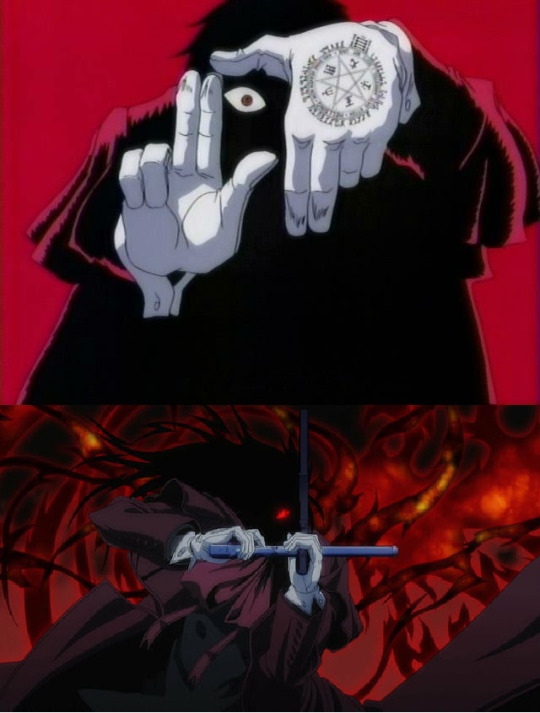
Speaking of his hands, let’s look at his gloves. Working from the outside in, we find Theban script, also known as the Witches’ Alphabet. Hirano’s Theban is poor, but we can make out enough to correct the script into what translates to “Hellsing”, “Hell’s Gate Arrested”, and “Shine Heaven Now”.

Closest to Alucard’s wrist, we see a number of 812. Knowing Hirano, this could just be a random number but I think the number refers to Gematria, a Jewish alphanumeric code that assigns numeric value to words and phrases, originally meant for the Torah. My favorite phrase I found that has a Gematric value of 812 is “Lucifer Begotten Son”, which would fall in line with the byname “Dracula” translating to “Son of the Dragon/Devil”.
And then we have the sigil, all placed within a circle. The sigil itself is reminiscent of those belonging to Goetic demons, found in the Ars Goetia, a section of “The Lesser Key of Solomon”. In the Ars Goetia, the Goetic demons images, descriptions, and sigils are displayed. For example, here is Astaroth’s sigil.

I think the way the sigil glows during the Cromwell Invocation means the sigil acts like a binding to Alucard as the sigils of the Goetic demons act to them.
The characters around the five-pointed star in Alucard’s sigil contain the alchemical symbols for Uranus and Neptune, representing the elements of Air and Water respectively, and stylized characters from other languages and cultures that represent the other three elements Fir, Earth, and Spirit.
And that’s all I can remember now, save for the references made in Stoker’s novel. I hope these are fun facts, because I have had fun picking up on them over the years.
126 notes
·
View notes
Text
really long but interesting article about zionist ecology. it talks about "making the desert bloom" - the JNF's mission to plant non-native pine trees in order to "beautify" the land + make it productive (thereby destroying the native environment esp olive trees, which became a symbol for palestinian resistance) and later about the concept of halutz as a means to reverse the "ultra-cosmopolitan" state of the jewish population through physical labor (which is kind of ironic considering it is essentially an acceptence of nazi völkisch and blood and soil rhetoric). it also talks about the use of coerced mizrahi labor and the role of female quasi-manual labor as a way of expanding early kibbutzim further into palestinian land, the latter of which is a common tool for the expansion of settler-colonial states.
8 notes
·
View notes